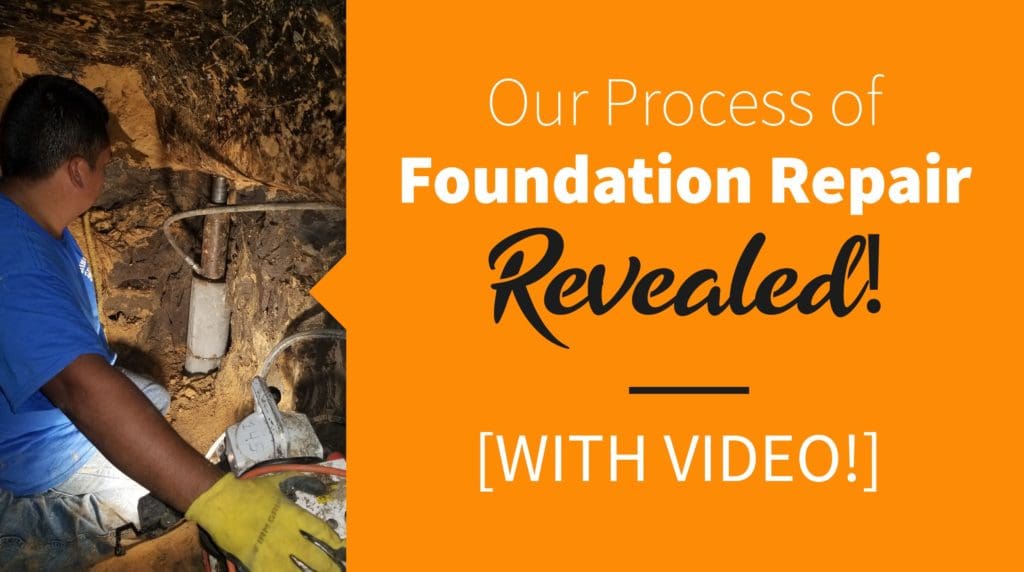Foundation repair is something that most people are unsure of. It seems like a scary phrase with a thousand different facets and negative connotations – but it is not nearly as bad as it seems! Allied has put together a quick and simple explanation of the process, explaining each individual step and how they function together as a whole. Foundation repair can be broken down into six easy steps; site preparation, excavation, ramming, leveling, backfill, and cleanup. While this is a birds-eye view of the process, it will hopefully take foundation repair from a frightening process to just another home repair project.
Site Preparation
The beginning of any foundation repair is site preparation, both outdoors, and, if necessary, indoors. Indoors, if any work needs to be done on the inside of the house, special preparation is done to ensure that it does not impact the house negatively. Plastic sheeting and tarps are used to cover furniture and floors to prevent any accidental damage or any dust or debris from ruining furniture. Outdoors, plywood boards, and tarps are placed on the ground to prevent damage to the yard from workers or the machinery that is used to complete the repair.
Excavation
For the next step of foundation repair, excavation is started. Pier holes for foundation repair are normally placed five to six feet apart, and the hole dimensions are, on average, 28 inches by 28 inches. These holes are placed under the load-bearing beam underneath the home. There may be a need to place pier holes under pier locations in places such as driveways, walkways, porches, and sometimes even interior locations. Piers that need to be placed there will often require jackhammering what is called a ‘breakout’ – a two-foot by two-foot hole to gain access to the beam. All of these holes will later be fixed, ensuring that there is no lasting damage in any way. Any decking against the home will be temporarily removed in order to preserve it while excavation is done.
Ramming
Ramming, or driving, is when solid concrete cylinders are placed into each excavated hole. The piers are six inches by twelve inches and are put in place by 25-ton portable hydraulic machines placed on the pre-placed boards to limit any unnecessary lawn damage. The depth at which the piers need to be placed will vary based on the soil type underneath the home. With soil that is on the sandier side, such as in areas of North and West Houston, the piers can be placed at a much more shallow depth. For soils that are expansive clay-type soils, such as the soil in South and East Houston, piers often need to be placed at a depth of up to forty feet, sometimes more. The driving process continues until the piles cannot penetrate the soil any further and the house starts to lift.
Leveling
For leveling, 20-ton bottle jacks are brought in to do a controlled lift. This lift is incredibly gradual, moving at a pace of only 1/8th of an inch at a time. Lifting continues until the desired height has been reached, at which point, concrete blocks are placed. Steel shims are also placed, in order to secure the lift and stabilize the slab. Leveling is done in order to lift the foundation back to where it originally was, or to get it as close as possible. This will return a home to its level state and fix problems that may have occurred with walls cracking and doors not closing correctly.
{% video_player “embed_player” overrideable=False, type=’scriptV4′, hide_playlist=True, viral_sharing=False, embed_button=False, autoplay=False, hidden_controls=False, loop=False, muted=False, full_width=False, width=’1920′, height=’1080′, player_id=’12234004410′, style=” %}
Backfill
All of the dirt that was excavated during the excavation process is then used to backfill the holes that were created for the piers. Any remaining dirt is hauled away and cleaned off of the property. Any concrete breakouts that were created to access the piers are filled with concrete and closed back up. If decking was removed to access any of the piers, the decking is now replaced. Backfilling is the part of the process where a home begins to look like a home again, not just a construction site!
Cleanup
Cleanup is the last step of the process and one that is given just as much detail as the rest of the process. A crew will spend a minimum of a few hours and consists of washing down the outside of the house to remove any debris from dirt or concrete dust. The house will also be swept, cleaning dust and dirt off of any decking but also from the inside of the house if work was completed inside as well as outside. All tarps and boards are cleaned up and removed from the lawn and the interior of the house. Any landscaping that needs to be put back in place will be done as well. Allied also ensures that customers are satisfied with not only the cleanup but the entire foundation repair as a whole by calling the next day and making sure that there were no oversights.
Sometimes the worst part about foundation repair is not knowing what to expect from the process. Allied Foundation wanted to alleviate that stress, and put together this guide on what the average foundation repair looks like. All it takes is six relatively simple steps to resolve foundation issues and keep a home running as smoothly as it possibly can. Foundation damages are not something to be ignored, and Allied offers free estimates on foundation repair – so do not hesitate to have a foundation examined if it shows signs of damage.

